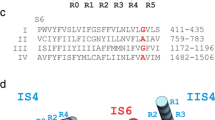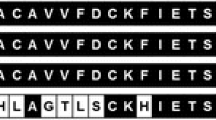Abstract
Glutamate scanning mutagenesis was used to assess the role of the calcicludine binding segment in regulating channel permeation and gating using both Ca2+ and Ba2+ as charge carriers. As expected, wild-type CaV1.2 channels had a Ba2+ conductance ~2× that in Ca2+ (GBa/GCa = 2) and activation was ~10 mV more positive in Ca2+ vs. Ba2+. Of the 11 mutants tested, F1126E was the only one that showed unique permeation and gating properties compared to the wild type. F1126E equalized the CaV1.2 channel conductance (GBa/GCa = 1) and activation voltage dependence between Ca2+ and Ba2+. Ba2+ permeation was reduced because the interactions among multiple Ba2+ ions and the pore were specifically altered for F1126E, which resulted in Ca2+-like ionic conductance and unitary current. However, the high-affinity block of monovalent cation flux was not altered for either Ca2+ or Ba2+. The half-activation voltage of F1126E in Ba2+ was depolarized to match that in Ca2+, which was unchanged from that in the wild type. As a result, the voltages for half-activation and half-inactivation of F1126E in Ba2+ and Ca2+ were similar to those of wild-type in Ca2+. This effect was specific to F1126E since F1126A did not affect the half-activation voltage in either Ca2+ or Ba2+. These results indicate that residues in the outer vestibule of the CaV1.2 channel pore are major determinants of channel gating, selectivity, and permeation.









Similar content being viewed by others
References
Babich O, Matveev V, Harris AL et al (2007) Ca2+-dependent inactivation of Ca(V)1.2 channels prevents Gd3+ block: does Ca2+ block the pore of inactivated channels? J Gen Physiol 129:477–483
Bean BP (1985) Two kinds of calcium channels in canine atrial cells. Differences in kinetics, selectivity and pharmacology. J Gen Physiol 86:1–30
Byerly L, Chase PB, Stimers JR (1985) Permeation and interaction of divalent cations in calcium channels of snail neurons. J Gen Physiol 85:491–518
Catterall WA, Perez-Reyes E, Snutch TP, Striessnig J (2005) International Union of Pharmacology. XLVIII. Nomenclature and structure-function relationships of voltage-gated calcium channels. Pharmacol Rev 57:411–425
Cens T, Rousset M, Kajava A et al (2007) Molecular determinant for specific Ca/Ba selectivity profiles of low and high threshold Ca2+ channels. J Gen Physiol 130:415–425
Corbett AM, Vanderklok MA (1994) Sodium-channel subtypes in the rat display functional differences in the presence of veratridine. Biochem Biophys Res Commun 199:1305–1312
Cota G, Stefani E (1984) Saturation of calcium channels and surface charge effects in skeletal muscle fibres of the frog. J Physiol 351:135–154
Dilmac N, Hilliard N, Hockerman GH (2003) Molecular determinants of Ca2+ potentiation of diltiazem block and Ca2+-dependent inactivation in the pore region of Ca(v)1.2. Mol Pharmacol 64:491–501
Dilmac N, Hilliard N, Hockerman GH (2004) Molecular determinants of frequency dependence and Ca2+ potentiation of verapamil block in the pore region of Ca(v)1.2. Mol Pharmacol 66:1236–1247
Ganitkevich V, Shuba MF, Smirnov SV (1988) Saturation of calcium channels in single isolated smooth muscle cells of guinea-pig taenia caeci. J Physiol 399:419–436
Hanck DA, Sheets MF (1992) Extracellular divalent and trivalent cation effects on sodium current kinetics in single canine cardiac Purkinje cells. J Physiol 454:267–298
Hille B (2001) Ion channels of excitable membranes, 3rd edn. Sinaur Associates, Sunderland, MA
Hille B, Woodhull AM, Shapiro BI (1975) Negative surface charge near sodium channels of nerve: divalent ions, monovalent ions, and pH. Philos Trans R Soc Lond B Biol Sci 270:301–318
Kaku T, Lee TS, Arita M et al (2003) The gating and conductance properties of CaV3.2 low-voltage-activated T-type calcium channels. Jpn J Physiol 53:165–172
Kass RS, Krafte DS (1987) Negative surface charge density near heart calcium channels. Relevance to block by dihydropyridines. J Gen Physiol 89:629–644
Khan N, Gray IP, Obejero-Paz CA et al (2008) Permeation and gating in Ca(V)3.1 (alpha 1G) T-type calcium channels effects of Ca2+, Ba2+, Mg2+, and Na+. J Gen Physiol 132:223–238
Klugbauer N, Marais E, Lacinova L et al (1999) A T-type calcium channel from mouse brain. Pflugers Arch 437:710–715
Kostyuk PG, Mironov SL, Shuba YM (1983) Two selective filters in the calcium channel of the molluscan neuron somatic membrane. Neurophysiology 15:314–319
Li JY, Stevens L, Klugbauer N et al (2004) Roles of molecular regions in determining differences between voltage dependence of activation of Ca(v)3.1 and Ca(v)1.2 calcium channels. J Biol Chem 279:26858–26867
Li JY, Stevens L, Wray D (2005) Molecular regions underlying the activation of low- and high-voltage activating calcium channels. Eur Biophys J 34:1017–1029
Marks TN, Jones SW (1992) Calcium currents in the A7r5 smooth muscle-derived cell line. An allosteric model for calcium channel activation and dihydropyridine agonist action. J Gen Physiol 99:367–390
Naranjo D, Latorre R (1993) Ion conduction in substates of the batrachotoxin-modified Na+ channel from toad skeletal muscle. Biophys J 64:1038–1050
Ohmori H, Yoshii M (1977) Surface potential reflected in both gating and permeation mechanisms of sodium and calcium channels of the tunicate egg cell membrane. J Physiol 267:429–463
Perez-Reyes E, Castellano A, Kim HS et al (1992) Cloning and expression of a cardiac/brain beta subunit of the L-type calcium channel. J Biol Chem 267:1792–1797
Peterson BZ, Catterall WA (2006) Allosteric interactions required for high-affinity binding of dihydropyridine antagonists to Ca(V)1.1 Channels are modulated by calcium in the pore. Mol Pharmacol 70:667–675
Peterson BZ, DeMaria CD, Adelman JP et al (1999) Calmodulin is the Ca2+ sensor for Ca2+-dependent inactivation of L-type calcium channels. Neuron 22:549–558
Peterson BZ, Lee JS, Mulle JG et al (2000) Critical determinants of Ca2+-dependent inactivation within an EF-hand motif of L-type Ca2+ channels. Biophys J 78:1906–1920
Qin N, Olcese R, Bransby M et al (1999) Ca2+-induced inhibition of the cardiac Ca2+ channel depends on calmodulin. Proc Natl Acad Sci USA 96:2435–2438
Sather WA, McCleskey EW (2003) Permeation and selectivity in calcium channels. Annu Rev Physiol 65:133–159
Sigworth FJ (1977) Na-current fluctuations give estimates of single-channel conductance in frog nerve. Biophys J 17:A10 A10
Sigworth FJ (1980) The variance of sodium current fluctuations at the node of Ranvier. J Physiol 307:97–129
Smith PA, Aschroft FM, Fewtrell CM (1993) Permeation and gating properties of the L-type calcium channel in mouse pancreatic beta cells. J Gen Physiol 101:767–797
Tomlinson WJ, Stea A, Bourinet E et al (1993) Functional properties of a neuronal class C L-type calcium channel. Neuropharmacology 32:1117–1126
Wang X, Ponoran TA, Rasmusson RL et al (2005) Amino acid substitutions in the pore of the Ca(V)1.2 calcium channel reduce barium currents without affecting calcium currents. Biophys J 89:1731–1743
Wang X, Du L, Peterson BZ (2007) Calcicludine binding to the outer pore of L-type calcium channels is allosterically coupled to dihydropyridine binding. Biochemistry 46:7590–7598
Wei XY, Perez-Reyes E, Lacerda AE et al (1991) Heterologous regulation of the cardiac Ca2+ channel alpha 1 subunit by skeletal muscle beta and gamma subunits. Implications for the structure of cardiac L-type Ca2+ channels. J Biol Chem 266:21943–21947
Williamson AV, Sather WA (1999) Nonglutamate pore residues in ion selection and conduction in voltage-gated Ca2+ channels. Biophys J 77:2575–2589
Wilson DL, Morimoto K, Tsuda Y et al (1983) Interaction between calcium ions and surface charge as it relates to calcium currents. J Membr Biol 72:117–130
Yarotskyy V, Gao G, Peterson BZ et al (2009) The Timothy syndrome mutation of cardiac CaV1.2 (L-type) channels: multiple altered gating mechanisms and pharmacological restoration of inactivation. J Physiol 587:551–565
Zamponi GW, Snutch TP (1996) Evidence for a specific site for modulation of calcium channel activation by external calcium ions. Pflugers Arch 431:470–472
Zheng J, Sigworth FJ (1997) Selectivity changes during activation of mutant Shaker potassium channels. J Gen Physiol 110:101–117
Zuhlke RD, Pitt GS, Deisseroth K et al (1999) Calmodulin supports both inactivation and facilitation of L-type calcium channels. Nature 399:159–162
Acknowledgments
We thank Yunhua Wang for great technical assistance. This project was funded in part by grants from the Pennsylvania Department of Health using Tobacco Settlement Funds and National Institutes of Health HL074143 (B.Z.P.) and the China Scholarship Council, Chinese Scholarship Fund (Z.L.).
Author information
Authors and Affiliations
Corresponding author
Rights and permissions
About this article
Cite this article
Li, Z., Wang, X., Gao, G. et al. A Single Amino Acid Change in CaV1.2 Channels Eliminates the Permeation and Gating Differences Between Ca2+ and Ba2+ . J Membrane Biol 233, 23–33 (2010). https://doi.org/10.1007/s00232-009-9221-1
Received:
Accepted:
Published:
Issue Date:
DOI: https://doi.org/10.1007/s00232-009-9221-1




